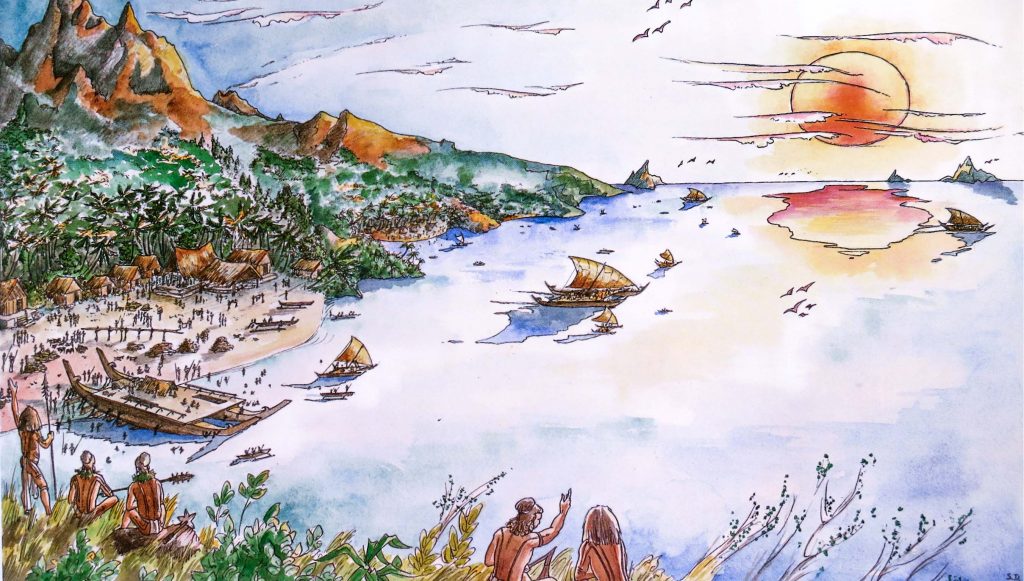Celebration of Heritage Day – Rapa Nui 2025
The body as a canvas, the earth as a pigment, and memory as inspiration: this was how the first edition of the TĀ TŪ Painted Body Festival on Rapa Nui was live.
By: Museo Rapa Nui – © Photos by Miguel Carrasco Bratti

Last Saturday, May 24th, at Kona Mana events hall of Nayara Hangaroa Hotel, the first edition of the “TĀ TŪ” Painted Body Festival was held, in the frame of the national celebration of Heritage Day 2025. The event brought together more than 300 people on a day filled with symbolism, art, and tradition.
The day began with an ancestral ceremony: an ‘Umu Hatu, a traditional Rapa Nui curanto, prepared by Paori Atan and Isabel Pakarati Tepano, a Living Human Treasure of Rapa Nui.


The ceremony was accompanied with a Rapa Nui catering with traditional preparations such as mañoka po’e, banana po’e, pumpkin po’e, taro desserts, natural guava juice, and local infusions, given to the attendees as part of the ceremonial welcome.
After the curanto, the opening ceremony began with the presentation of the ancestral chanting group Hauha’a Tupuna, led by teacher Aru Patē. In an original and deeply moving performance, they combined chants, storytelling, and traditional legends. Through their voices, they revived the legend of Uho o te Uka and the story of Kuha and Rati, interweav-ing music and storytelling to provide a ceremonial and cultural framework at the begin-ning of the festival.



Subsequently ,The tā tū competition began, divided into two blocks. A total of seven com-petitors participated, who, along with their respective artists and painters, worked from 5:00 p.m. in the dressing rooms, preparing every detail of their bodies as living canvases.
Three competitors participated in the first block:
1 – Haukena Ika Mella: with her work Mōai Hinariru, stood out for her high-contrast body painting and precise color execution.
2 – Māhatu de Rycke Atán: stood out for her stage presence and physical connection to the story.
3 – Raŋi Nui Atan: presented a work based on the Mōai Kava-kava and their spirits, trans-mitting a profound mythological narrative through his body.
In the second block, four people competed:
4 – Korikē Encina: who embodied the god Make-Make, a central figure in Rapa Nui cos-mogony, with ritual power and stage presence.
5 – Amelia Pakarati Atan: Visually recounted the story of the taŋata manu and the arrival of the birds, linking body and ancestral ritual.
6 – Lucy Haoa Tuki: Shared a work inspired by her genealogy and the oral history of two siblings, reinforcing the role of family storytelling in Rapa Nui culture.
7 – Pio Haoa Riroroko: Closed the competition with a presentation that brought together various elements of the notional Rapa Nui, including the representation of the Mōai Hoa Haka Nana Ia.

The jury, composed by Rodrigo Paoa Atamu, María Eugenia Tuki Pakarati, and Cristian Araki Silva, had the difficult task of evaluating each proposal based on criteria of scenic composition, use of the Rapa Nui language, narrative quality, and artistic execution.
Each participant received a certificate of recognition, and the top three places were awarded stone sculptures inspired by Vai a Heva, a sacred figure located in Pōike. The awards were crafted by prominent Rapa Nui sculptor Juan “Nano” Ika Araya, so that artists could use them as containers for mixing natural pigments, ensuring the continuity of their practice.

Heritage passports were also distributed during the event, stamped as proof of participa-tion, and commemorative stickers were given out. In addition, five official festival T-shirts were raffled off among attendees.
The official host of the event was Nani Tuki Pont, Queen of Tāpati Rapa Nui 2020, who led every moment of the day with warmth and elegance.
At the festival’s closing, the juries offered a few words to the attendees. Rodrigo Paoa Atamu stated: “Many people confuse the tā tū with the tā kona. The idea is to educate through these activities and motivate young Rapa Nui people to keep their culture alive,” he said in Rapa Nui. María Eugenia Tuki Pakarati, delivered a direct message to the partic-ipants: “Remember to keep your language alive and always bring it forward. Your Rapa Nui language is your identity,” also spoken in her ancestral language.
The TĀ TŪ 2025 Festival consolidates as a new platform for cultural expression and revi-talization of Rapa Nui’s intangible heritage, uniting past, present, and future in a single evening of art, body, and memory.

For more details and photographs of the event, you can visit the full article on the Museum website: museorapanui.gob.cl



